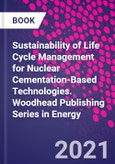Sustainability of Life Cycle Management for Nuclear Cementation-Based Technologies, edited by Dr. Rahman and Dr. Ojovan, presents the latest knowledge and research on the management of cementitious systems within nuclear power plants. The book covers aging, development and updates on regulatory frameworks on a global scale, the development of cementitious systems for the immobilization of problematic wastes, and the decommissioning and decontamination of complex cementitious systems. The book's editors and their team of experts combine their practical knowledge to provide the reader with a thorough understanding on the sustainability of lifecycle management of cementitious systems within the nuclear industry.
Sections provide a comparative tool that presents national regulations concerning cementitious systems within nuclear power plants, check international and national evaluation results of the sustainability of different systems, help in the development of performance test procedures, and provide a guide on aging nuclear power plants and the long-term behavior of these systems in active and passive safety environments.
Please Note: This is an On Demand product, delivery may take up to 11 working days after payment has been received.
Table of Contents
1. Introduction to the nuclear industry sustainability 2. Innovative and conventional cementitious systems in nuclear industry -safety aspect 3. Life cycle of nuclear cementitious structures, systems and components 4. Hydration kinetics and thermodynamics 5. Long-term irradiation effects in cementitious systems 6. Sustainability of cementitious structures, systems, and components (SSC): Long term environmental stressors 7. Behavior of cementitious SSC's in mitigating accidents 8. Consideration in construction of systems 9. Innovative and conventional materials and designs of nuclear cementitious systems in radioactive waste management 10. Sustainability consideration during the design and construction of Geological Disposal 11. Preventive maintenance of cementitious systems (including mitigation of natural phenomena effects) 12. Techniques to test cementitious systems through its life cycle 13. End of Life cycle management for aged cementitious SSCs: lessons learned and case studies 14. Innovative and conventional decontamination techniques for cementitious structure 15. Dismantling and demolition techniques for cementitious systems 16. Innovative and conventional techniques for managing the produced wastes 17. Case studies and lessons learned from decontamination, demolition, and managing the produced wastes 18. Terms and Glossary Relevant to Nuclear Cementitious Systems








